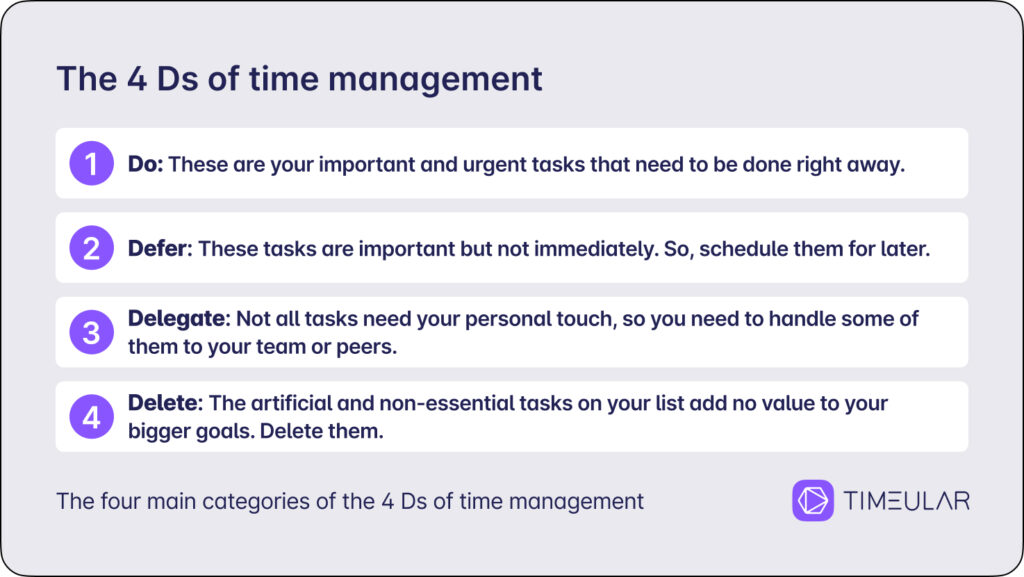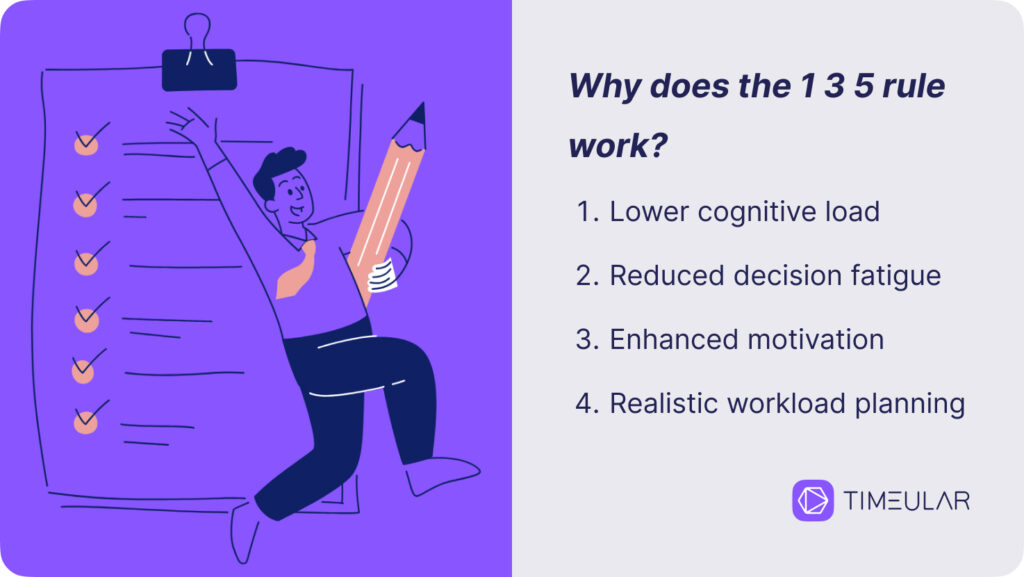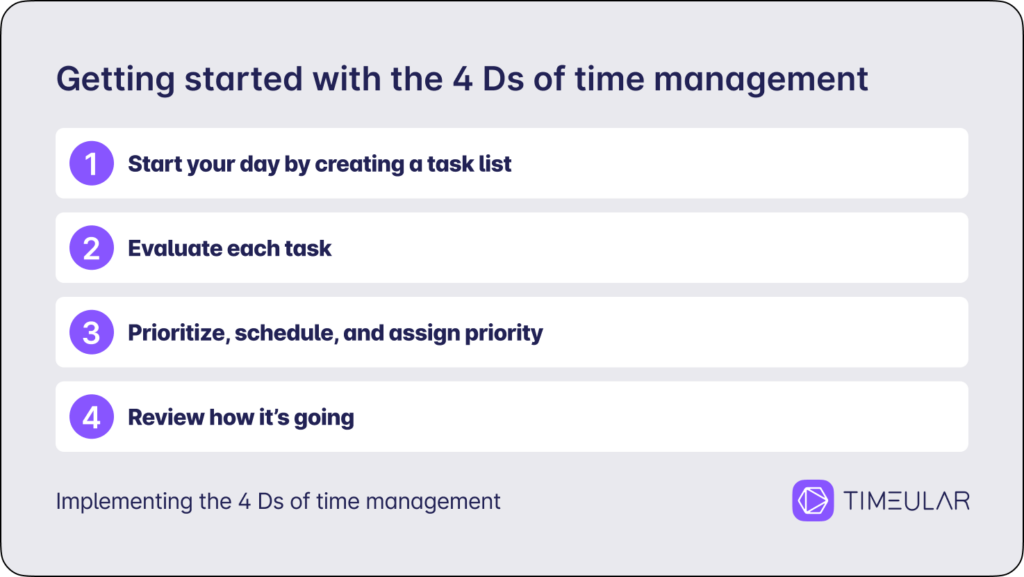The 4 Ds of Time Management: Blueprint for Productivity
How many of your days end up with you feeling like you did not progress with work except for putting out fires? If your answer is “I can’t even count – too many days,” then you need a structured approach to organize your tasks.
The 4Ds of time management help you cluster your tasks by their urgency and importance and then prioritize them in a strategic way.

What are the 4Ds of time management?
The 4 Ds of time management is a straightforward framework that helps you categorize and prioritize tasks based on four main categories: Do, Defer, Delegate, and Delete. In other words, you learn to identify tasks that need to be done immediately, tasks that can be delayed until later, and others that can be delegated to your peers or deleted altogether.
The best part about it is that you’re gaining clarity over your work and escaping feelings of overwhelm or toxic productivity.

TLDR: The 4 Ds of time management
Let’s jump into the meaning of the four categories of the 4 Ds of time management. Note that I’ll give you specific examples during the article and how to implement them.
- Do: These are your important and urgent tasks that need to be done right away, as these either block a project’s progress or have hard deadlines looming on you.
- Defer: In this category, you find the so-called “fake urgent tasks.” That means that these are important and should be done by you, but not immediately. So, deferred tasks can be scheduled for later on.
- Delegate: Not all tasks need your personal touch, so you need to hand over some of them to your team or peers so you can focus on the higher priorities.
- Delete: The reality is that we’re creating extra work to sometimes feel useful or because we’re overcomplicating things, but these might not add value or align with our goals. So we need to delete all these non-essential tasks.
💡 Pro tip: If you have difficulty with delegating or deleting tasks, you should learn more strategies on how to protect your energy. You’ll see a big difference in your productivity levels as it helps you regain time control.
The origin of the 4 Ds of time management
Managing conflicting goals and task prioritization is not a new topic. Its importance is tackled in many studies, such as
“Managing conflicting goals through prioritization? The role of age and relative goal importance,” published in the National Library of Medicine.
The framework of the 4 Ds of time management was popularized first in time management theories in the 20th century. It was particularly influenced by the concept of the time management matrix created by the former President of the United States, Dwight Eisenhower, in 1954, which, since then, has been refined by productivity experts.
As a content writer, I discovered the 4Ds method after missing a crucial website copy deadline because I was buried in ‘urgent’ tasks – like endless social media captions and minor edits to published posts. Once I started categorizing my work using the 4Ds, I realized that 60% of what I labeled as ‘urgent’ was just noise. Now, instead of juggling twelve different client projects, I ruthlessly prioritize. The result? Better work, on-time delivery, and I finally have my evenings back.
Why is the 4D framework useful?
The 4 Ds work like a structured framework that helps you combat overwhelm and gain clarity on how to approach not only your tasks but your entire workday. The 4 Ds give you a more efficient time management process and, by default, better time management skills.
Here’s why this framework is a game-changer:
- It eliminates decision fatigue: Your work is complex enough – you need to utilize your mental capacity to tackle your high-priority tasks, not consume it on repetitive tasks. The more you think about your tasks and how to tackle them, the more your capacity to make decisions decreases. The 4 Ds minimize overthinking.
- It fosters creativity and productivity. By clearly defining what everyday tasks deserve your immediate attention and which ones can be set aside, you free up mental resources. This mental bandwidth can be used to be more creative, innovative, and productive in your work.
- It brings a sense of control: The 4 Ds turn your previously overwhelming workload into a series of achievable steps. In turn, you feel more confident and have more peace of mind, as opposed to being anxious in front of a chaotic to-do list.

Getting started with the 4 Ds of time management
Let’s explore a strategic way of assessing your tasks with this time management technique and how to distinguish between urgent but important tasks and non-urgent tasks. Getting started with the 4 Ds is easier than you might think. Here’s a step-by-step guide that you can follow:

1. Start your day by creating a task list
Write down everything you need to do, no matter how big or small. At this stage, don’t filter or categorize activities, just aim to jot them down.
For instance, your list might include tasks like “preparing a pitch for a potential client,” “scheduling a one-on-one call,” “following up with one vendor,” or “responding to a client’s email.”
Make sure you have a complete inventory so you can gain a realistic picture of what’s on your plate.
💡 Pro tip: If a task takes less than 5 minutes and it’s important, do it now, don’t procrastinate. The 1 3 5 rule of productivity might help you implement this simple 5-minute rule.
2. Evaluate each task
Once you’ve compiled your list, it’s time for task management to emerge. Now, you need to fiercely assess all tasks by importance and urgency.
A. Is it urgent and important? → I’ll do it!
Assess if these tasks have significant consequences if delayed. For instance, you promised a potential client that you’d send your offer or a client emailed you last evening that the campaign you’re running for them is not performing at all – these are tasks that don’t afford delays. Otherwise, these will have negative consequences. So, you need to prioritize them as soon as possible.
B. Is it important, but can it wait? → I’ll defer it!
Note that you can postpone tasks in this category, but they are critical, too. However, the difference between “doing ASAP” to “deferred tasks” is that the latter is not time-sensitive. For instance, if you’re a marketing content manager, you need to create the strategy for this quarter to send it to your writers or organize files for a new project that starts in a week. So, schedule these for later when you can dedicate focused time.
C. Can someone else handle this better or faster? → I’ll delegate it!
Some tasks end up on your list sometimes for different reasons, but it’s not mandatory for them to stick on your list. For instance, if you’re pressed by a client pitch and there’s a meeting that can be held by someone in the team, handle the coordination. It can be a great opportunity for them to grow and for you to maintain focus on what’s urgent.
D. Does the task add no real value? → I’ll delete it!
There are unnecessary tasks that might seem important at first glance but don’t contribute to your goals. For instance, there are non-essential meetings that you could skip or spend time on low-impact social media updates. Be bold in removing these from your list entirely – these are stealing your time and are definitely not urgent and important tasks.
| EVALUATE EACH TASK | INDICATORS | ACTION |
|---|---|---|
| Is it urgent and important? | The task: 1. has a deadline today 2. significantly impacts a project’s progress 3. has negative consequences if not done ASAP | I’ll do it |
| Is it important but not urgent? | The task: 1. is critical but not time-sensitive 2. can be scheduled for later 3. requires focused time to complete | I’ll defer it |
| Can someone else handle this task? | The task: 1. doesn’t need your expertise 2. can be effectively completed by someone else 3. involves routine or repetitive work | I’ll delegate it |
| Does the task add no real value? | The task: 1. doesn’t contribute to your goals 2. is non-essential or low-impact 3. can be skipped without consequences. | I’ll delete it |
3. Prioritize, schedule, and assign priority
Once you’ve categorized your tasks with the 4 Ds of time management, it’s time to organize and prioritize all the tasks.
Not all “Do” tasks will have the same level of urgency, nor are all “Defer” tasks equally important. Take a moment to analyze the relative importance and urgency of each task within its category, and add them in the order you need to finalize them.
| CATEGORY | TASK EXAMPLE | PRIORITY | ACTION |
|---|---|---|---|
| Do | Submit client pitch by 5 PM | High urgency and importance | Start this immediately to hit the deadline and potentially win a new client. |
| Do | Respond urgent emails | Lower urgency but important | Handle this task after finishing the high-priority ones in the “Do” category. It should be handled next, as otherwise, it blocks progress on other projects. |
| Defer | Draft next month’s marketing campaign | Important but not time-sensitive | Schedule this task in a time block later in the week. It needs your manager’s budget approval, but you still have this week to finalize it. |
| Defer | Update the team handbook | Low urgency and long-term importance | Set a later deadline for this one since it does not impact immediate goals or deliverables. |
| Delegate | Routine data entry | Low importance and suitable for others | Assign this task to a colleague or search for an automated tool to handle this faster on Friday this week. |
| Delete | Non-essential meeting that could have been an email | Adds no real value | Politely decline or remove from your schedule to focus on your most high-level tasks. |
💡 Pro tip: Still struggling to decline some work or meetings, even if these are clearly in the unimportant tasks category? I get you! The best thing you can learn is how to say no to work.
4. Review how it’s going
Time management isn’t a one-and-done activity. It’s a constant decision-making process, and you must adjust your time management strategy based on your progress.
A time audit done with an automatic time-tracking app simplifies your analysis. You can perform a quick audit at the end of each week and assess how you’ve spent time on all your tasks. This way, you can reveal if you had a tendency to misplan or categorize tasks wrongly or if you did not allocate enough time slots for complex tasks and other issues.
If you consider it useful, you can monitor the progress even twice a week. This helps you reshift your focus, reprioritize tasks immediately upon need, or set priorities differently.

Try automatic time tracking for 14 days and see if your productivity transforms or it needs adjustments.
Do’s and dont’s in applying the 4 Ds
For great outcomes in implementing the 4 Ds, it’s best to keep in mind some best practices to maximize their effectiveness. Check out this quick guide when implementing this framework:
| DO’S | DON’TS |
|---|---|
| Do categorize tasks objectively based on urgency and importance | Don’t overthink task categories – quick decisions are key to efficiency |
| Do delegate tasks that others can handle effectively | Don’t micromanage or take back tasks you’ve already delegated |
| Do review your task list regularly and adjust as priorities shift | Don’t assume your initial categorization is set in stone—adapt constantly |
| Do be bold about eliminating non-essential tasks from your list | Don’t hold onto unnecessary, non-urgent tasks out of guilt or fear of missing out |
| Do pair the 4 Ds with tools like time trackers or project management apps | Don’t rely solely on memory or a chaotic task list – it defeats the purpose of the system |
| Do focus on finishing one category or task at a time | Don’t multitask or let distractions pull you away from your prioritized work |
Cons of the 4 Ds of time management
Even if the 4Ds is one of the most efficient strategies, it has its fair share of pros and cons. All these depend on case by case, but here are some general limitations:
- It requires discipline: To truly benefit from the 4 Ds, you need to apply it with consistency. It’s easy to fall back into old habits of multitasking or hoarding tasks out of fear of delegating or deleting, and you’re undermining its effectiveness.
- It’s not always clear-cut: Some activities may not fit into the four categories with precision, which can make it hard to categorize tasks. With time, you’re learning to be faster in deciding how to categorize them, so it’s best to give it time to get into full gear.
- It relies on trust for delegation: Particularly for delegating, you need to trust your peers or team, and if you don’t, this can make it hard for you to delegate. Moreover, poor delegation or lack of follow-up can lead to poor outcomes. Hence, you need to make sure you’re learning how to manage this process.
- Deleting tasks may feel uncomfortable: Sometimes, having a pile of tasks makes us feel valuable, needed, and productive. Otherwise, you might feel guilty, which stops you from deleting them. It’s best to grow your skill of identifying what truly brings the real impact.
- It may overlook long-term planning: The 4 Ds focus on categorizing and managing immediate tasks but don’t inherently address long-term goals or strategic planning. You need to make sure you have goal-setting frameworks or systems so you don’t miss the bigger picture.
Start taking control of your tasks
As a final note, it’s important to keep in mind that this could be recognized as a simple method, but its effectiveness can be great for anyone, from project managers to entrepreneurs and in your personal life.
If you want to improve your productivity and control your own time, the 4 Ds are an exceptional choice for you and your project’s life cycle progress. It’s also important to understand that this method might not suit you, but you must evaluate your options first and consider a trial run of the 4 D’s.
Once you have formed your opinions about it, you can decide what’s best for your specific case.
FAQs
Who benefits from the 4 Ds of time management?
Anyone juggling multiple tasks can benefit from the 4 Ds, including professionals, entrepreneurs, students, and even busy parents. It’s a versatile framework that helps anyone prioritize and manage their time more effectively.
Can the 4 Ds of time management be adapted for personal use?
Yes, the 4 Ds can be easily applied to personal tasks like household chores, fitness routines, meal planning, or managing family schedules. So don’t hesitate to use it for any particular task.
How do I decide what to delegate?
You can delegate tasks that don’t require your specific skills or expertise but can be effectively handled by someone else. These tasks are also stealing time from your most important and urgent tasks. For example, routine data entry, scheduling, or administrative tasks are ideal for delegation.
Sources: